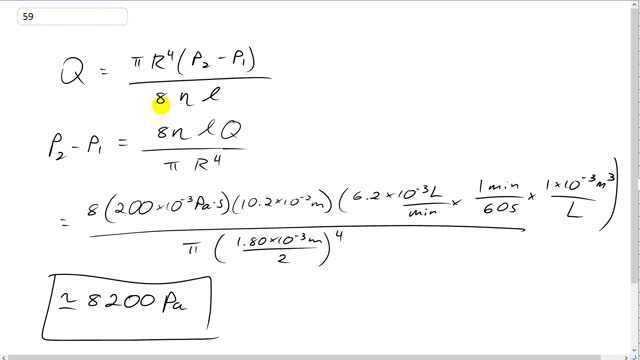
Engine oil (assume SAE 10, Table 10–3) passes through a fine 1.80-mm-diameter tube that is 10.2 cm long. What pressure difference is needed to maintain a flow rate of 6.2 mL/min?

In order to watch this solution you need to have a subscription.
This is Giancoli Answers with Mr. Dychko. Poiseuille's equation says that the volume rate of flow is π times the inner radius of the tube to the power of 4 times the pressure difference divided by 8 times the coefficient of viscosity of the fluid times the length of the tube. So we can solve for P 2 minus P 1 by multiplying both sides by 8ηl over πR to the power of 4 and we get this and we have to go 8 times η times l times... (did I call it a 'mu'? that's an 'eta' by the way) so this is 8 times η times l times Q over πR to the power of 4 and so that's 8 times 200 times 10 to the minus 3 pascal seconds is the viscosity for SAE 10 motor oil times 10.2 times 10 to the minus 2 meters is the length of the tube and then we multiply by the volume rate of flow converted into cubic meters per second so we have 6.2 times 10 to the minus 3 liters per minute and times by 1 minute for every 60 seconds and then times by 10 to the minus 3 meters cubed for every liter and then divide that by π times the diameter divided by 2 to get the radius and we have to express this in meters so that's 1.80 millimeters is actually 1.80 times 10 to the minus 3 meters over 2 to get the radius to the power of 4 and in the calculator, it looks like this and that's 8200 pascals needs to be the pressure difference.